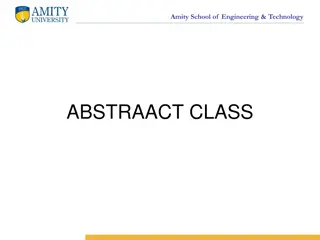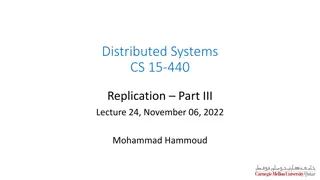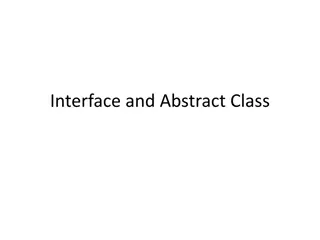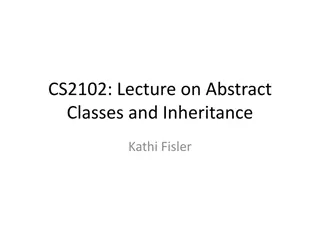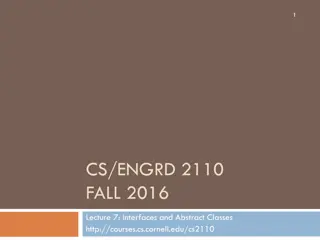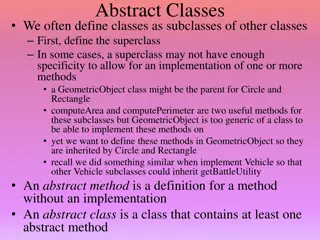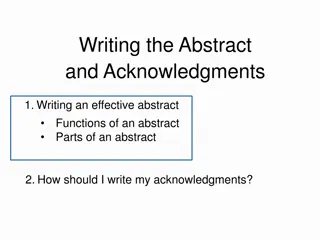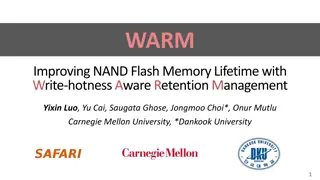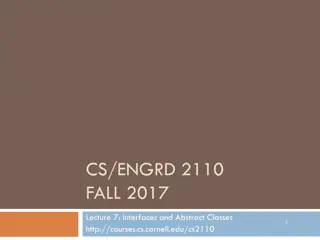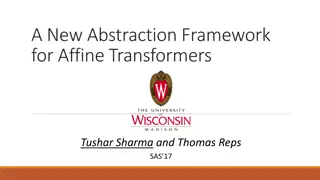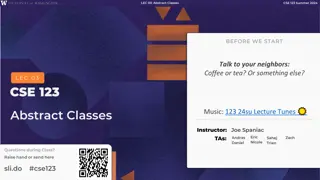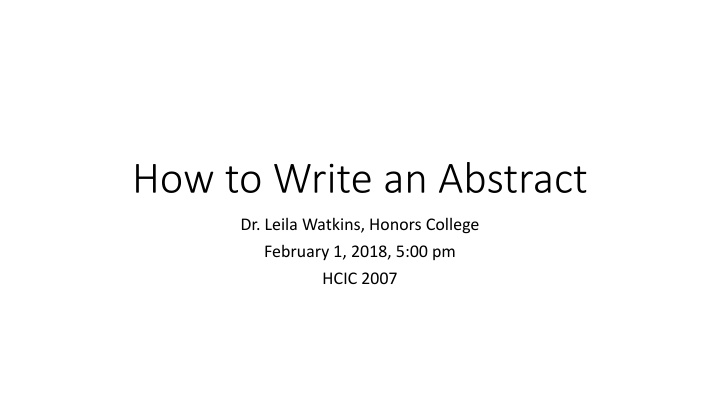
Crafting an Effective Abstract for Scholarly Communication
Learn how to write a compelling abstract for academic purposes, such as conferences, research grants, and publications. Understand the purpose of an abstract, identify the target audience, and organize key information effectively to enhance the visibility and impact of your work in scholarly circles.
Download Presentation

Please find below an Image/Link to download the presentation.
The content on the website is provided AS IS for your information and personal use only. It may not be sold, licensed, or shared on other websites without obtaining consent from the author. If you encounter any issues during the download, it is possible that the publisher has removed the file from their server.
You are allowed to download the files provided on this website for personal or commercial use, subject to the condition that they are used lawfully. All files are the property of their respective owners.
The content on the website is provided AS IS for your information and personal use only. It may not be sold, licensed, or shared on other websites without obtaining consent from the author.
E N D
Presentation Transcript
How to Write an Abstract Dr. Leila Watkins, Honors College February 1, 2018, 5:00 pm HCIC 2007
What is the Purpose of My Abstract? To propose a talk, poster, performance, etc. for a conference? If you are applying to the SRC, this is your purpose. To apply for a research grant or other funding? To provide an overview of my completed project for indexing purposes (library database, literature review, etc.)?
Who is the Audience for My Abstract? Specialists or professionals directly in my field of study? Highly educated non-specialists (such as professors from a variety of academic, creative, and professional fields)? This is the audience for the SRC abstracts. Book, journal, or other publication editor? The general public?
Have I Completed the Project Yet? If Yes If No Abstract should provide a clear summary of your findings or results that can stand in for the larger work. Say exactly what you created, argued, found, concluded. Abstract should map out a clear potential direction for the project. Summarize main research question and goals. Outline methods, materials, data sets, etc. you will use to address your research question.
Typical Process of Thought when Developing a Project What am I interested in?/What do I want to do? How will I do this? Here s what I found and why it s important to others in my field.
Explaining a Project to an Audience with Limited Time and Interest This is why you should care about my project [and keep reading this abstract]. This is what my research found (or hopes to find). / This I what I made (or will make). This is how I did it (or will do it).
How Do I Organize My Abstract? 1. What is my general topic of inquiry? Why is it important? (Outer Circle) 2. What specific question or issue in the field am I addressing? (Middle Circle) 3. What did I find?/What will I do to answer this question? (This is where you describe specific methods, techniques, results, materials, etc. (Bull s Eye)
Alisha Ali and Stephan Wolfert, Theatre as a treatment for posttraumatic stress in military veterans: Exploring the psychotherapeutic potential of mimetic induction, The Arts in Psychotherapy 50 (2016): 58-65. Current mainstream treatments for traumatic stress in military veterans are largely inadequate in meeting the needs of veterans who are reluctant to conform to conventional illness-based approaches, including medication. These approaches have been criticized for using rigid techniques that emphasize strict symptom-reduction without considering social and relational factors in veterans lives. There is thus a need for innovative treatment models for traumatic stress that acknowledge potential sources of resilience and healing in veterans existing communities. In particular, there is growing evidence that the arts can play an important role in supporting veterans recovery from trauma. Accordingly, this paper describes a strengths-based group psychotherapy model that uses theatre and specific techniques from classical actor training in combination with empirically-established trauma treatment techniques from cognitive processing therapy and narrative therapy to address posttraumatic stress in veterans. Three case examples of veterans are presented with a focus on the veterans experiences of mimetic induction, a process through which the narrative representation of fictional encounters simulates real-world encounters at a safe aesthetic distance and thereby fosters self-awareness and positive psychological transformation.
What is our general field of inquiry? Why is it important? Current mainstream treatments for traumatic stress in military veterans are largely inadequate in meeting the needs of veterans who are reluctant to conform to conventional illness-based approaches, including medication. These approaches have been criticized for using rigid techniques that emphasize strict symptom-reduction without considering social and relational factors in veterans lives. What specific question in the field are we addressing? There is thus a need for innovative treatment models for traumatic stress that acknowledge potential sources of resilience and healing in veterans existing communities. In particular, there is growing evidence that the arts can play an important role in supporting veterans recovery from trauma. What did we find?/What will we do to answer this question? Accordingly, this paper describes a strengths-based group psychotherapy model that uses theatre and specific techniques from classical actor training in combination with empirically-established trauma treatment techniques from cognitive processing therapy and narrative therapy to address posttraumatic stress in veterans. Three case examples of veterans are presented with a focus on the veterans experiences of mimetic induction, a process through which the narrative representation of fictional encounters simulates real-world encounters at a safe aesthetic distance and thereby fosters self-awareness and positive psychological transformation.
A Novel Synthetic Biology Method to Study the Cooperative Behavior of Kinesin Motors in Cells Authors: Stephen R. Norris 1,2, Virupakshi Soppina 2, Aslan S. Dizaji 2, David Sept 3, Dawen Cai 2, Sivaraj Sivaramakrishnan 1,2, and Kristen J. Verhey 1,2 Departments of Biophysics 1, Cell and Developmental Biology 2, Department of Biomedical Engineering 3, University of Michigan, Ann Arbor, MI 48109 Molecular motor proteins such as kinesin, dynein, and myosin are essential for the organization and function of cells. These motors move along the cytoskeleton to transport cellular cargo including organelles, vesicles, and even viruses to specific locations within the cell at specific times. Since its discovery in 1985, the motor protein kinesin has been studied intensively on an individual, single-molecule level. In cells, however, kinesin is thought to work in teams where multiple motors cooperate to transport cargo; unfortunately, this team-based behavior remains poorly understood. Here, we develop a protein-based synthetic biology method to assemble teams of kinesin motors on an artificial cargo, the first such method to be developed inside cells. First, we describe the system s development and use FRET and two-color TIRF microscopy to demonstrate our control of motor number and spacing in cells with nanometer precision. Second, we use a combination of live-cell TIRF imaging and automated image tracking to show that mixtures of multiple motors are highly dependent on the state of their microtubule track inside cells. Together, this cutting-edge study provides a new approach to study multi-protein behavior in cells, and will be critical for our understanding of motor-related diseases such as neurodegeneration and cancer.
What is our general field of inquiry? Why is it important? Molecular motor proteins such as kinesin, dynein, and myosin are essential for the organization and function of cells. These motors move along the cytoskeleton to transport cellular cargo including organelles, vesicles, and even viruses to specific locations within the cell at specific times. What specific question in the field are we addressing? Since its discovery in 1985, the motor protein kinesin has been studied intensively on an individual, single-molecule level. In cells, however, kinesin is thought to work in teams where multiple motors cooperate to transport cargo; unfortunately, this team-based behavior remains poorly understood. What did we find?/What will we do to answer this question? Here, we develop a protein-based synthetic biology method to assemble teams of kinesin motors on an artificial cargo, the first such method to be developed inside cells. First, we describe the system s development and use FRET and two-color TIRF microscopy to demonstrate our control of motor number and spacing in cells with nanometer precision. Second, we use a combination of live-cell TIRF imaging and automated image tracking to show that mixtures of multiple motors are highly dependent on the state of their microtubule track inside cells. Together, this cutting-edge study provides a new approach to study multi-protein behavior in cells, and will be critical for our understanding of motor-related diseases such as neurodegeneration and cancer.
Mistakes to Avoid Overly creative titles that make it difficult to figure out the topic of the presentation. Overly creative or fluffy introductory sentences. Have you ever wondered Since the beginning of history Webster s Dictionary defines A famous person once said Extensive references to the work of other specific scholars (referring to the general state of scholarship is ok). Academic or technical jargon (especially in the earlier sentences of the abstract)
Multi-Author Projects Be sure to give credit to everyone who contributed to the project. Generally, but not always, if you are presenting a paper or a poster, you are the first author. If authors belong to different academic departments, it may be necessary to specify departmental affiliation as well. Always ask your advisor or principal investigator about the proper order for listing authors and departmental affiliations.





